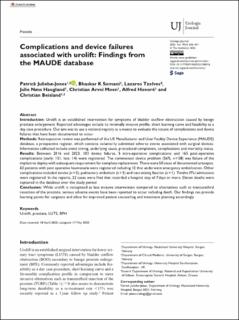| dc.contributor.author | Jones, Charles Patrick W. | |
| dc.contributor.author | Somani, Bhaskar K | |
| dc.contributor.author | Tzelves, Lazaros | |
| dc.contributor.author | Haugland, Julie Nøss | |
| dc.contributor.author | Moen, Christian Arvei | |
| dc.contributor.author | Honoré, Alfred | |
| dc.contributor.author | Beisland, Christian | |
| dc.date.accessioned | 2024-03-12T13:55:38Z | |
| dc.date.available | 2024-03-12T13:55:38Z | |
| dc.date.created | 2023-07-12T10:16:11Z | |
| dc.date.issued | 2023 | |
| dc.identifier.issn | 0391-5603 | |
| dc.identifier.uri | https://hdl.handle.net/11250/3121997 | |
| dc.description.abstract | Introduction: Urolift is an established intervention for symptoms of bladder outflow obstruction caused by benign prostate enlargement. Reported advantages include its minimally invasive profile, short learning curve and feasibility as a day case procedure. Our aim was to use a national registry as a means to evaluate the nature of complications and device failures that have been documented to occur.
Methods: Retrospective review was performed of the US Manufacturer and User Facility Device Experience (MAUDE) database, a prospective register, which contains voluntarily submitted adverse events associated with surgical devices. Information collected include event timing, underlying cause, procedural completion, complications and mortality status.
Results: Between 2016 and 2023, 103 device failures, 5 intra-operative complications and 165 post-operative complications (early: 151, late: 14) were registered. The commonest device problem (56%, n = 58) was failure of the implant to deploy with subsequent requirement for complete replacement. There were 50 cases of documented urosepsis. 62 patients with post operative haematuria were registered including 12 that underwent emergency embolisation. Other complications included stroke (n = 5), pulmonary embolism (n = 3) and necrotising fasciitis (n = 1). Twelve ITU admissions were registered. In the reports, 22 cases were filed that recorded a hospital stay of 7 days or more. Eleven deaths were captured in the database over the study period.
Conclusion: While urolift is recognised as less invasive intervention compared to alternatives such as transurethral resection of the prostate, serious adverse events have been reported to occur including death. Our findings can provide learning points for surgeons and allow for improved patient counselling and treatment planning accordingly. | en_US |
| dc.language.iso | eng | en_US |
| dc.publisher | SAGE | en_US |
| dc.rights | Navngivelse 4.0 Internasjonal | * |
| dc.rights.uri | http://creativecommons.org/licenses/by/4.0/deed.no | * |
| dc.title | Complications and device failures associated with urolift: Findings from the MAUDE database | en_US |
| dc.type | Journal article | en_US |
| dc.type | Peer reviewed | en_US |
| dc.description.version | publishedVersion | en_US |
| dc.rights.holder | Copyright 2023 the authors | en_US |
| cristin.ispublished | true | |
| cristin.fulltext | original | |
| cristin.qualitycode | 1 | |
| dc.identifier.doi | 10.1177/03915603231180016 | |
| dc.identifier.cristin | 2162068 | |
| dc.source.journal | Urologia | en_US |
| dc.source.pagenumber | 636-641 | en_US |
| dc.identifier.citation | Urologia. 2023, 90 (4), 636-641. | en_US |
| dc.source.volume | 90 | en_US |
| dc.source.issue | 4 | en_US |

